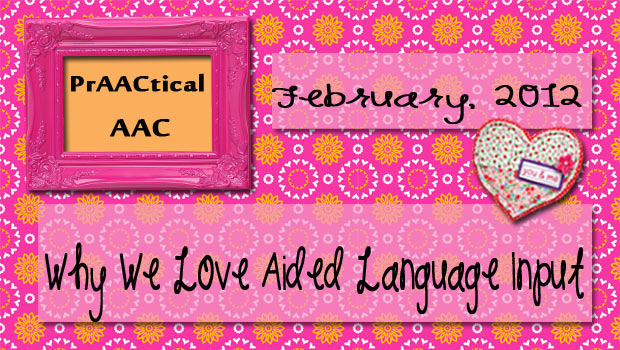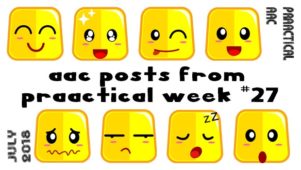Why We Love Aided Language Input

The concept of Aided Language Input is simple: Speak AAC to the learner. If you were teaching her French, you’d speak to her in French. No one would dispute that hearing the new language is an essential prerequisite to learning i t. It’s the same in AAC. If we want our folks to learn to express themselves with AAC, they have to have a lot of expose to people speaking AAC.
t. It’s the same in AAC. If we want our folks to learn to express themselves with AAC, they have to have a lot of expose to people speaking AAC.
 t. It’s the same in AAC. If we want our folks to learn to express themselves with AAC, they have to have a lot of expose to people speaking AAC.
t. It’s the same in AAC. If we want our folks to learn to express themselves with AAC, they have to have a lot of expose to people speaking AAC.–
Here are the top reasons we are such strong advocates of this as an intervention strategy.
–
1. It has a strong research base, thanks to studies by Kathryn Drager, Cathy Binger and Janice Light, Jennifer Kent-Walsh, Shakila Dada, and others.
1. It has a strong research base, thanks to studies by Kathryn Drager, Cathy Binger and Janice Light, Jennifer Kent-Walsh, Shakila Dada, and others.
–
2. It is the fastest way for a clinician, teacher, or parents to get familiar with the language in the AAC device. If we don’t know what words are in there and where they are located, can we really expect to be good interventionists?
2. It is the fastest way for a clinician, teacher, or parents to get familiar with the language in the AAC device. If we don’t know what words are in there and where they are located, can we really expect to be good interventionists?
–
3. It provides valuable learning opportunities for the person using AAC. Think of how many spoken words a typically developing child hears before they start to speak. And these are kids with no organic problems! Our folks learning AAC need at least that amount of exposure to the way they are going to communicate (AAC).
–
4. Everyone can do it. This is not a strategy reserved for highly trained professionals. Some of the best implementers I’ve ever seen of this strategy were paraprofessionals and family members. Even peers can get in on the action. Learning from friends? Yes, please!
–
5. It can be done everywhere. No special equipment needed. Classroom, playground, restaurant, therapy room, kitchen. Once you start to learn the person’s AAC system, this is a highly portable strategy that you can implement with no preparation. No additional prep? Love that!
–
6. It’s contagious. Want more people to start using aided language input with an AAC user you know and love? Use it yourself as often as possible and pretty soon you will notice others following your lead.
–
Are you using aided language input? Tell us about your experiences. We’d sure like to hear what’s going on in your part of the world.
–
–
Filed under: Strategy of the Month
Tagged With: intervention, teaching strategy
This post was written by Carole Zangari





3 Comments
I would like to briefly discuss Aided Language Input with you. I have a son with special needs and he is 22 now. He uses a iPad for communication and does quite well. One concern we have is the therapist points to the word/icon on his iPad as she works with him. He has always been able to find the spot to touch to answer a question or to count numbers.We are concerned he could get dependent on people showing him where to touch by people doing it automatically each time. Is there a way to talk to you on line chat or by telephone briefly? Hope to hear from you. Thank you.
Gene, I think of aided language input as speaking to AAC learners in the language that they are trying to acquire. If we were teaching them French, we’d speak to them in French, right? This is pretty much the same thing. We are giving them a competent model of what AAC looks/sounds like using their system. As long as the therapists and educators are using it in that way, as opposed to a prompt for imitation, there isn’t likely to be an issue with dependency. If they ARE modeling to get your son to imitate, which is not uncommon in the early stages, then it would be good to ensure that they have a plan for gradually fading those prompts.
Aided language input can also help with receptive language problems. It slows down your rate of speech, allows the user to hear your words in a voice that they hear all the time, and gives visual support corresponding to what you just said.